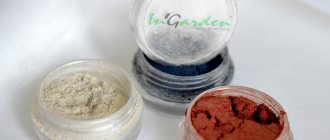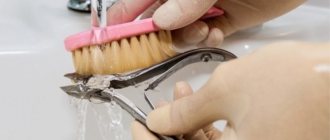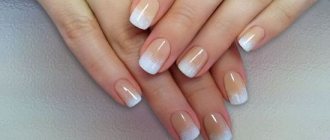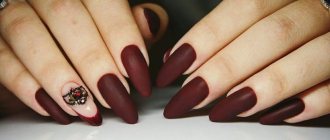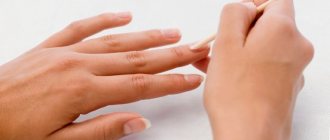Congratulations if you are seriously thinking about how to make money doing manicures. Services for creating the beauty of women's nails will always be relevant, because painting them yourself requires special skill. And with modern technologies and materials, any client’s fantasy can be fulfilled.
If you are just planning to become a nail artist, there are three options for earning money: working in a salon at a rate, renting, or opening a business at home. Each of them has its own advantages and disadvantages. Well, we’ll talk further about how to make money from manicures in all three cases.
Pros and cons of working as a manicurist
Benefits of working as a nail technician:
- A good start for career growth and development.
- Availability of materials for nail extension and correction, which can be purchased in any store or ordered online.
- Wide selection of nail extension products.
- Registering your individual entrepreneur while working from home is much cheaper.
- The opportunity to turn all your creative ideas into reality.
But there are also some disadvantages:
- It is difficult to keep up as there are too many competitors in the market.
- It is important to always stay on trend, because nail design fashion changes from season to season.
- Lack of truly capable craftsmen.
At the start of her activity, a manicurist needs to decide how she will work, choose a schedule, number of clients, types of services, etc.
Manicure specialists can be divided into several types:
- Those who work in salons and beauty studios.
- Registering individual entrepreneurs and opening their own studio.
- Masters providing manicure services at home.
- A mobile specialist who, by prior arrangement, comes to the client’s home.
Each option has its pros and cons. Today, the earnings of a manicurist depend on various factors. We will tell you further in our article how much and how to earn money from manicure.
What equipment do you need to purchase?
You need to start a manicure business with the appropriate set of tools and equipment. And first in line are hand manicure tools and electrical appliances. You will need:
- nail scissors and special ones for cutting cuticles;
- file;
- sticks and pushers;
- buff (emery file);
- brush;
- drill.
The next thing to think about is cosmetics sets, which include:
- degreasers (preferably a kit);
- base;
- colored gel polish (you can learn how to do a manicure with gel polish yourself);
- top – varnish fixer.
Over time, you will receive more and more requests from clients for nail colors, which means your set of manicure cosmetics will slowly grow.
It is impossible not to mention various consumables, such as disposable napkins, towels and much more.
You will need good lighting, ceiling and local, electrical equipment for sterilizing instruments, for quickly drying nails, as well as additional equipment (special hand rest, manicure fan, etc.)
Special mention should be made about the chairs. You will have to spend a lot of time in your desk chair. They should be comfortable. By the way, it should be convenient for the client too. A correctly selected table is also important for the successful and comfortable work of a manicurist.
Approximate income of a nail artist
Specialists who work in a large team of various beauty salons and manicure studios, as a rule, receive about 40% of the cost of services. But at the same time the master works with his own instruments.
Despite the low earnings, this option will allow you to quickly get in the swing of things, develop your client base, and meet interesting people. Among the advantages of this work option, one can note the savings on materials, since they are provided by the owner of the salon. Thus, the master does not have to spend money on consumables.
Registering your own individual entrepreneur and opening a personal salon is a more difficult task. It is important to think through everything down to the smallest detail: select and rent premises, purchase equipment, consumables, find good craftsmen, organize workplaces. And no one canceled the legal part: registration of the salon, promotion, collection and preparation of documents.
All this will require serious time and financial investments. There are also enough risks in this option. Huge competition leads to many salons closing. But, if you approach the matter wisely and properly promote the salon, then it will begin to bring in stable and high income.
How to make money doing manicures at home? The first step is to set up a workplace, purchase materials, get better at it and find clients. Manicurists working from home earn good money.
This option significantly saves time and allows you to build your business comfortably, leaving personal space for yourself, without being tied to your superiors. Providing manicure services at home saves money on salon rental and transportation costs.
But you will have to spend money on advertising, purchasing equipment, furniture, materials and other details.
An on-site manicure is one of the most inconvenient options, as a lot of time is spent on the road. You don’t always have to work in comfortable conditions, and you also have to carry heavy bags with the necessary equipment and materials, which can also get damaged along the way.
But such masters, as a rule, have high prices, plus an extra charge for visiting the house.
Analyzing all 4 options, we can say that the most convenient are working from home and opening your own salon. But a novice specialist should work in a salon at least for a short time, get better at it and find clients.
Even a novice specialist can make good money doing manicures. The client evaluates not the master’s track record, but the quality of the work performed, the readiness to implement interesting ideas, the approach and style of execution.
Manicure is a creative process, not a simple monotonous job, so it is important to find an individual approach to each client.

To understand how to make money doing manicures at home, you first need to figure out how much such specialists earn on average. Today, manicurists who provide services at home earn from 12 thousand rubles. up to 100 thousand rubles.
The amount varies depending on the region, the number of clients and the quality of services. A beginning master can charge from 300 rubles for a simple manicure, and even if you take on 3 clients a day, you can already earn about 1,000 rubles, and in a five-day work week up to 20,000 thousand rubles, which is quite good for a beginner.
Once you’ve gotten your head around it and collected enough material for a professional portfolio, you can raise prices and attract more new clients, thereby increasing profits by 2-3 times.
How much does a manicurist earn in a salon? Newcomers who work in a beauty salon as trainees earn from 6,000 thousand rubles per month. More experienced craftsmen have salaries of 30 thousand rubles and above. Income depends on the prestige of the salon and the number of clients. Regardless of your experience and quality of work, you must give the salon 40% of the amount the client pays for your services.

What do you need to do a manicure?
The very first thing is the desire to give beauty to women's nails. This requires not only knowledge, but also appropriate attributes.
Equipment and tools

Minimum set for manicure
A good purchase for a newly minted master will be a starter set that includes:
- Manicure scissors.
- A set of glass or ceramic files.
- Metal tweezers.
- Polishing buff.
- Tweezers for clamping.
- Forms for modeling.
- Bath for steaming hands.
- Dust removal brush.
- Orange stick.
- Pusher.
- Brushes for painting.
- Containers for sterilization.
- Ultraviolet lamp. It is necessary for gel extensions or quick drying of thick varnish.
This is a list of tools without which a manicure cannot be done, but for professionals it is much longer.
Materials
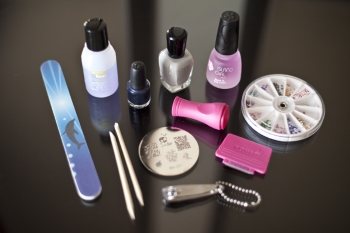
Materials for manicure
To carry out a regular manicure procedure, you will need to use not only tools, but also purchase special cosmetics:
- Cotton buds.
- Nail polish remover.
- Cuticle softening oils.
- Varnish, gel polish, shellac.
- Tips.
- Base coat.
- Primer.
- Hand cream.
- Disinfectant solution.
- Finish coating.
- Degreaser.
- Acrylic paints.
- Decorations.
After such preparation, clients will appreciate the professional approach of the new master and will be able to relax during the procedure.
Manicure training for beginners
Have you decided to train as a nail technician? Where should I start? Study on your own or under the guidance of experienced professionals? Let's figure it out.
Nuances of self-study:
- It is extremely difficult to understand the flow of available information. Trying to study the entire unstructured volume of materials on the basics of manicure, you will spend more effort and time. Moreover, there is a chance that you will never understand the execution technique.
- In order to practice everything you study, you will have to spend money on purchasing training materials.
- In addition to materials, you need to find models who will agree so that you can start learning the basics of nail service with them.
- No one will tell you whether you are doing the right thing or point out mistakes, which will create even greater misunderstanding.
Why you should choose professional manicure training:
- Save time. A certified expert will correctly convey to you all the necessary information on manicure techniques and help you perfect it in a matter of days.
- Saving money. The specialist will give you an accurate list of the most necessary and proven consumables for honing your skills, which will eliminate spending on the purchase of products that are useless at the start of work.
- By studying at a nail service school, you don’t have to buy tools and equipment. This is all provided by the educational institution.
- In addition to tools and materials, you will be provided with models on which you can practice, and an expert will point out all the mistakes and tell you how to correct them.
- By studying with an expert, you will be able to prepare a portfolio of work completed during your studies. This will allow you to start earning money immediately after completing the course.
- Upon completion of the course, you will be issued a diploma confirming your qualifications, with which you can find work in any salon.
Where to start to become a professional from scratch?
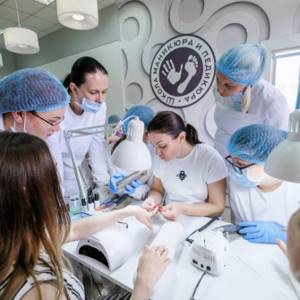
The first thing to start with is training. Of course, there is the option to study on your own, but it is unlikely that articles and videos from the Internet will be enough to become a sought-after professional. In addition, it will take much more time than when attending courses taught by experienced professionals.
Important! In addition, home training is not confirmed by anything, and any client can and has the right to demand a certificate. You will receive it in the courses, and this will already be a good start for work.
At what age can you work?
Age restrictions vary for different courses. Most people start studying at the age of 18, but some schools accept students from 15–16 years old. But you should understand that few people will trust a minor master, so in some cases it’s worth waiting a couple of years.
How should you choose courses to get started?
If you plan to get serious about manicure, don't skimp on training. This is what will allow you to get the base necessary for a successful start. Find a good school where you can master all aspects of professional manicure:
- hygienic manicure;
- nail extensions;
- various designs.

To really learn, choose a general form of learning.
Attention! Typically, the courses provide all consumables, and also provide practice, during which you can practice the acquired theory on models.
The main parameters when choosing courses are as follows:
- price of training;
- duration of the entire course and lessons;
- training program, list of required topics;
- schedule;
- number of people in groups.
- school location;
- the document you will receive upon completion of the course.
Each student chooses for himself what is important to him:
- quality of training;
- school location;
- affordable price;
- or diploma.
This topic needs to be analyzed carefully and from various aspects. Understand that good courses don't come cheap. Don't be fooled by a suspiciously low price. The cost will depend on:
- rental prices;
- teachers' salaries;
- programs used.
In addition, these are high-quality equipment and consumables, the number of people in the group and the duration of the classes.

Sometimes the price is reduced by increasing the number of people in the group and offering to buy equipment and consumables on their own.
- The first option is definitely unsuccessful: if there are more than 6–8 people in a group, the teacher technically cannot pay attention to everyone.
- If we talk about materials, then this option is suitable for some - it does not provide an opportunity to save money, but it can be a successful investment for the future. At the end of the course, everything purchased will remain with you, and you can practice or immediately start working from home.
Reference. When evaluating hours of training, take into account whether the training will be full or part-time, what hours are considered - academic or astronomical, blocks or continuous topics.
It is optimal if training is carried out like this:
- “topic of the day” blocks – the teacher gives theory and demonstration, then the student practices the knowledge himself;
- full days - certain procedures and technologies require a lot of time to master;
- richness of the program - in addition to the manicure itself, they should provide knowledge regarding sanitation, safety, dermatology;
- strict schedule - it is important that the training program is systematized and easy to understand for beginners.
If you have the opportunity to study not for a long time, but through intensive courses on specific topics, you can choose this option. It gives you the opportunity to delve deeper into the topic and gain exactly the knowledge that you need now.
Upon completion of training you must receive a certain document. Having a state diploma is a plus, but you shouldn’t chase it. For both clients and beauty salon administrations, professionalism is more important than a piece of paper about courses.
Manicurist starter kit
Well, the most exciting question for any beginning nail technician is how much it costs to become a specialist. Let's do the math.
What expenses do you expect:
- Training and basic education.
- Purchase of tools (nippers, scissors, orange sticks, files, pushers).
- Equipment for manicure (lamp for drying nail polish, table lamp, fan for sucking nail dust).
- Materials (disinfectors, primers, base, glossy and matte top, dehydrator, at least 5-6 colored varnishes, lint-free wipes).
- Materials for nail design (foil, rhinestones, 5-6 sliders, rubs).
- Products for disinfection (box, solution).
- Personal protective equipment (cap, gloves, masks, apron).
This is the most simplified starter kit. Of course, it is not at all enough for a professional manicure, but for a beginning specialist whose budget is limited, such a set will be just right.
It is also worth considering that you will have to spend money on organizing your workplace. You may need to rent furniture or equipment. Remember that if you have definitely decided that nail service is yours and you want to grow and improve in this area, then you are already close to success.
The main thing is not to be afraid to experiment, develop and keep up with trends. Success and earnings depend on your passion for the process and desire to become the best in your business.
How quickly will all the costs of training and the purchase of basic materials be recouped? If you decide to start by working in a salon, then the salary will be approximately 25 thousand rubles per month. The advantages: you will receive official employment, acquire a regular client base and will not spend money on purchasing equipment and materials.
If you start making money doing manicures at home or as a mobile specialist, your income will be approximately the same, depending on the number of clients and the speed of your work.
Even having one client per day with a manicure costing 1000 rubles, you will already earn about 22 thousand rubles per month, working 5 days a week. And this is already at the start of my career, as a beginner. Consequently, all your investments will pay off in 2-3 months.
How to become a successful professional?
There are many manicurists, but not all of them are successful and truly professional. Time, patience and maximum absorption of the information given in the courses are important. To achieve success in the service industry you need:
- It is ideal to know the structure of the nail plate and improve this knowledge in practice.
- Be able to select the best manicure options for clients and justify this choice.
- Follow fashion trends in the nail industry, learn new designs, buy various add-ons for manicure (foil, pebbles, stickers, etc.). The ability to paint on nails is a plus in favor of the master. For this, additional courses are usually taken.
- Organize your workplace conveniently and beautifully. Everything you need should be at hand and at the same time not get in your way.
- Constantly learn, develop and improve.
Next, you can watch a video on how to become a successful manicurist:
Opening a nail salon at home
How to make money doing manicures if you decide to open your own individual entrepreneur? The first step is to register yourself as an individual entrepreneur with the tax service. To create a manicure salon, the same code is used as for hair salons. Next, you pay the receipt, collect the package of necessary documents and file them with the tax office.
After all the paperwork, you should decide on the taxation system. You can choose for yourself UTII or simplified tax system. The second option is much simpler and clearer, so it’s better to stick with it.

When your individual entrepreneur is officially registered and registered, you have to buy a cash register directly from the tax authorities. You will have to wait about 20 days for such a device, so plan your work in advance, taking into account the waiting period.
If you need the device urgently, then there are special services that sell cash registers that will deliver the device to you in just 3 days, but it costs much more.
Also, when registering an individual entrepreneur, do not forget to order a stamp; it is needed in any business, regardless of your income or expenses. There is no way around this moment.

What skills should an eyebrow artist have?
It is a common belief that any cosmetologist and makeup artist is able to create beautiful and well-groomed eyebrows. It's a delusion. To cope with such work, a specialist must take appropriate courses and receive a certificate as confirmation of professional skills. Want to know what it takes to work as an eyebrow artist? A brow master must be able to:
- take good care of your eyebrows,
- reconstruct eyebrow arches;
- engage in eyebrow architecture;
- tint hair.
It is extremely important that the specialist can choose a color that will give the eyebrow arches the desired shade.
Only an eyebrow artist who has worked for at least 1 year can be considered a professional.
Mandatory rules for doing business
- Regardless of where you work, all tools and work surfaces must be sterile clean. Follow safety rules.
- You must always work with gloves. In order not to clog the space, all nail dust should be swept away, and the surface of the tables should be thoroughly cleaned and treated with an antiseptic.
- A manicurist must undergo regular medical examinations and have a medical certificate.
- Buy quality materials for work. Choose gel coatings from trusted brands and manufacturers. The quality of the materials determines the result of the manicure performed and the period of its wear, and, accordingly, the client’s trust.
- Don't forget about the client's comfort. Wherever you provide your services, the client should be satisfied. Create a pleasant atmosphere for him and greet him with a smile.
- Adapt to the wishes of the customers; if the client does not like experiments, then you should not be unauthorized. Learn to establish contact and hear the desires of clients, your profit will depend on this.
How to get the hang of a novice master
The profession of a manicurist requires practice and constant improvement of acquired skills. At the first stage, training is very helpful - we are not talking about online courses, but offline lessons, where each technique will have to be honed on a model. It may be difficult, and a manicure procedure with the simplest coating will take you several hours.
Over time, you will learn to do everything as quickly as possible - from cleaning to design. Professional masters do a single-color manicure under the cuticle in 40–50 minutes. But this ability comes with experience - after many weeks of struggling with sagging, unevenness, detachments and other unpleasant surprises. Hone your skills on those close to you - the price tag can be set to a minimum, because your first clients will not always be delighted with the result.
Promoting manicurist services on Instagram
Promoting nail extension services through Instagram is the most effective advertising option. This social network can attract the attention of a large number of people with minimal investment.
Create a personal account, publish 9-12 of your works. Make a description of the services, price list, indicate the address and publish free windows in stories.
How to make money doing manicures through Instagram:
- Use Hashtags . They help promote a nail salon if you use the right tags and indicate the geolocation of your city.
- Fill your publications with interesting content . High-quality photographs are, of course, good, but it is better if there is useful text under the photo. This could be advice to clients, recommendations for caring for hand skin, cuticles, information about materials used, techniques, life hacks or news.
- Paid advertising . If you don’t know anything about advertising, then you can attract customers by buying advertising from popular bloggers.
How else to attract customers? If you are opening your own nail salon, then prepare thoroughly. Organize drawings, organize master classes, decorate the facade, invite guests, order a photographer and videographer. Make a photo report about the event for social networks.
Your task is to create a good reputation for your salon. Take care to select polite staff and provide customers with quality service. The fruits of your efforts will not take long to arrive.
Types of manicure courses
Most often, courses offer three training programs:
| Program | Description | |
| 1. | Starting | It is chosen by those who want to learn how to do manicures for themselves and their loved ones. It costs less than others, but it includes theory, practical exercises and video lessons. |
| 2. | Standard | It is suitable for beginners who plan to take care of their nails professionally in the future. After completing the entire proposed course, the student must pass a test, after a positive result of which a certificate is issued. |
| 3. | Professional | This program includes more practical sessions with a teacher, assignments on live models, group and individual consultations, and discussion of problems in special forums. At the end of such a course it will be necessary to pass exams in theory and practice. |
List of tools and equipment
Well-known brands offer eyebrow artists starter kits with dyes or henna. But those tools that are not included in the set will still have to be purchased by the master himself. So, let's talk about what is needed for an eyebrow artist, the list will be quite large:
Brushes are better if they are high-quality synthetic ones. They should perfectly follow your actions and not push at the wrong moment;
Tweezers are the main weapon of an eyebrow artist. Correction with tweezers is a universal and reliable method. They are different:
- with straight edges - usually used for thick eyebrows;
- with sharp edges - allows you to reach the finest hairs, reduces pain to a minimum;
- with beveled edges - the narrow edge will capture the thinnest and shortest hairs, and the thick one will pull out the long ones.
Wax. It is rarely used when working with fairly thick eyebrows. The method is quite traumatic.
Threads. One of the newest methods of getting rid of excess hair. Demonstration of the master’s professionalism and virtuosity. When modeling eyebrows with thread, you usually have to resort to other working tools.
A brow master cannot do without tools. Consumables list:
- cotton pads and sticks,
- disposable brushes (brushes),
- micellar water,
- eyebrow cleansing shampoos,
- facial scrub or gel peeling.
As well as scissors, pencils, and a container for mixing coloring compounds.
Prospect for opening a studio
If your business goes uphill and you manage to develop a stable, large client base; When all the costs are paid off and you understand that you are ready to develop this business and move to a new level, you may be faced with the prospect of opening your own manicure salon.
Of course, investments in such a business will be much more serious than purchasing gel polishes and nail files, but the income from running your own salon will significantly exceed the figure with which you started. But more on that in the next article.
Required knowledge and skills
One of the fundamental factors that allows you to develop in the field of nail services is your level of competence . Of course, you can get basic knowledge yourself from articles on the Internet and master classes on YouTube, fortunately there are plenty of them, but if you are counting on a target audience wider than your relatives and friends, it is highly recommended to undergo professional training in manicurist courses. You will find the average pricing policy for such courses at the end of the article.
So, for average audience coverage you need to know the technology:
- sterilization of instruments and treatment of the work area;
- edged, hardware, combi manicure;
- applying a single-color coating and simple designs, French manicure, gradient;
- performing simple and medium-complex designs;
- pedicure basics.
These skills will be enough for you to serve a client with “ordinary” needs, but if you want to reach the widest possible and are ready to work with a client with increased needs, you will need to learn:
- extend nails;
- apply complex designs to the coating;
- carry out highly complex designs;
- work with problematic fingernails and toenails.
Having completed training on all of the above points, you will be able to satisfy the desires of even the most demanding client.


